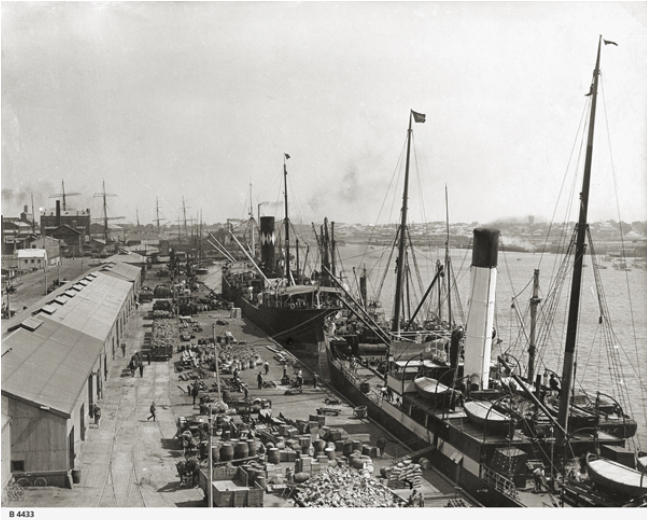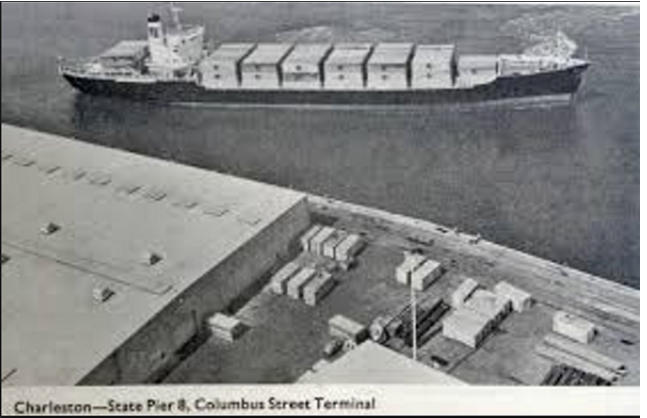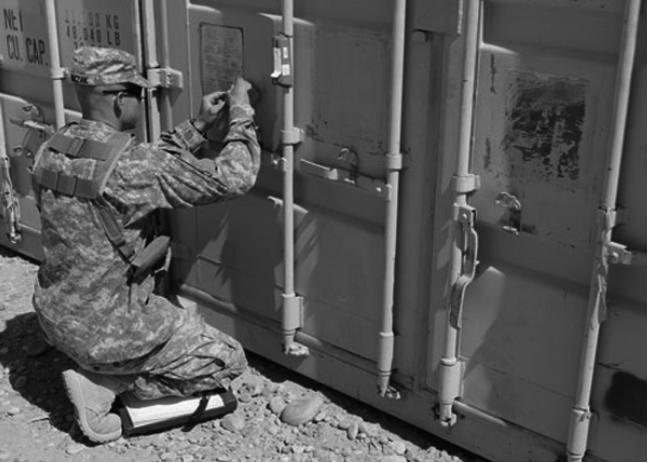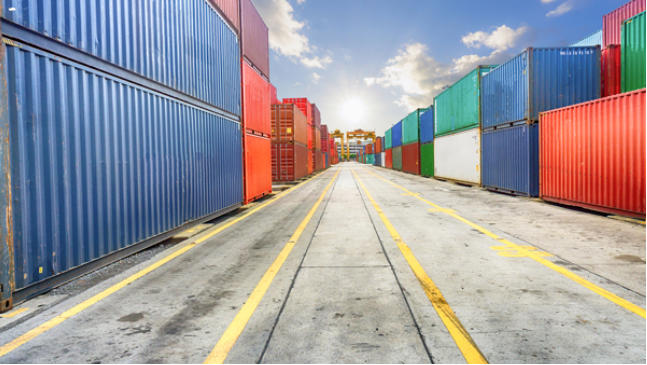From Wooden Crates To Steel Boxes
History of Shipping Containers
Many people think the Shipping Container was invented in China, but this is untrue. There were a few localized attempts to create some type of a containerization concept in a few parts of the world. Still, the first successful shipping container was invented and patented in 1956 by an American named Malcolm McLean. (1914-2001) Malcolm later changed his name spelling to Malcom.
McLean was not an ocean shipper, but he was a trucker, and by 1955, he owned the largest trucking fleet in the Southern US, and the fifth-largest trucking company in all the United States. He had diligently saved his money and bought his first truck in 1934. Things grew rapidly from there.

[Photo: State Library of South Australia archives]
Cargo loading process prior to 1956
For hundreds of years, and still in 1056, all cargo was loaded and unloaded in odd-sized wooden crates and barrels. The process was very slow, laborious, and certainly not standardized.
After observing this slow and inefficient process for 20 years, he finally decided to step back and develop a much-needed standardized way of loading cargo from trucks onto ships and into warehouses.
In the early 1950s, McLean began his own “container concept’ however, his final design was not patented until 1956, soon after he sold his trucking company for $25 million.
Malcom then purchased Pan Atlantic Tanker Company in 1956, which owned a group of fairly rusted tankers. He then repaired and converted the tankers to accommodate his new
containerized shipping concept. He later renamed the new shipping company Sea-Land Shipping. With this new shipping company and concept, he could now experiment with better ways to more efficiently load and unload trucks and ships.
After many experiments, his final design is what we know now as the ISO Container. Super strong, uniform design, theft resistant, stackable, easy to load, unload, truck, rail, ship, and certainly storable.

[Credit: Wheels Of Time archives] [Digitally optimized by Green Quest Research Staff]
Malcom McLean's Sea-Land Shipping Company
A company named Matson, on the West coast of the US, also attempted a type of container concept but failed sorely.
In the late 1960s, Sea-Land got some huge boosts from the US Government and US Military. These boosts were strategic to the success of ISO Containers in three important areas:
1) International traffic and acceptance
2) Global Standardization policies by ISO, IMO, and the United Nations
3) Economic strength and stability. The US military was 40% of Sea-Land's revenue during the years of 1968-1969 just from shipping to Vietnam alone. This 40% did not include shipments to any of the other US facilities globally.
McLean sold his remaining stock in the Sea-Land shipping company for $160 million in 1969; the shipping container industry was still struggling and was not yet standardized globally.
McLean still owned patents, even though he sold Sea-Land. With the boost from the US Navy, McLean and Sea-Land were able to finally standardize the container concept in the early 70's. Soon after, his containerization concept was globally accepted in a joint convention by the International Maritime Organization (IMO) and the United Nations.
Sea-Land Corporation was later acquired by Maersk Shipping in 1999.Most people in the container and shipping industry realize that although McLean had the first feasible concept and working system in 1956 with many patents, it was the US military that finally did what was necessary to make the ISO Containers accepted by every shipping line and country of the world.

[Credit: Wheels Of Time archives] [Digitally optimized by Green Quest Research Staff]
Loading a Sea-Land container 1970
Because ISO shipping containers were so much faster and organized to load/unload, the cost of loading freight onto ships and trucks was reduced by more than 90%. Thus, the cost of products you sell or buy was also significantly reduced because of the invention and standardization of the ISO shipping container.
In 1956, loose cargo cost $5.86 per ton to load.
Using an ISO shipping container, the cargo cost was reduced to only 16 cents per ton.
The shipping container invention of Malcom McLean has undoubtedly changed the world and thus, it has dramatically changed the lives of every human on the planet.
Many other people had similar concepts previously, but McLean was simply the guy who, with the push of the US military, really made the "standardized container" concept spread globally.

Photos: (center) Creative Commons, (left) Time Life Pictures/Getty Images; Edward Burtynsky
Despite many obstacles, Malcom McLean made it happen…
A few of Malcom McLean’s awards and recognitions:
• In 2000 he was awarded "Man Of The Century" by the International Maritime Hall of Fame, and an honorary Degree by the Merchant Marine Academy.
• Honored by Fortune Magazine and American Heritage Magazine.
• Awarded Patent 2,853,968 by the US Patent office in 1958 which was recognized globally.
Suggested Resources- Malcom Mc Lean
• The Truck Driver Who Re-invented Shipping
• Wikipedia: Malcolm McLean
• PBS: Who Made America? Containerized Shipping
• Twentieth Century Leaders Database
The Strongest Box In the World
The popularity of the strongest box in the world didn’t explode as fast as most people think.
Although the global use of ISO Containers has been massive for the past 3 ½ decades, the acceptance of the concept was not as immediate and initially grew, principally with the immediate support and use by the US military.

[National Defense Magazine archives]
The US Military, shipping containers, and Malcom McLean
For the first few years, from 1956 to 1965, virtually all of McLean's shipping containers were used only on his own ships.
His investments in shipping companies grew, and these shipping companies he invested in did use his "containerization concepts", but the world was still not using shipping containers.
We must remember that the ISO shipping container as we know it today was developed in 1956 but was not re-designed and standardized Internationally until 1972.
The standardization process, which began by the ISO and IMO in 1967, was only pushed forward at the urging of the US Government for their use by the US military for transport and housing overseas.
Shipments using ISO containers by the US military began between the US and Asia in 1967, surging in 1968 and 1969. The container services were expanded to Taiwan and Hong Kong in 1969, followed by service to the Philippines, Singapore, and Thailand in about 1971. Only in the late 1970s and early 1980s did the remainder of the world become a part of the "containerization boom.
"Unsurprisingly, "Containerization" originated in the US because the United States was still the economic superpower, largest global economy, and manufacturer. However, with the advent of the PC and related high-tech industries, Asian countries began to dominate exports more than the US.
It's also interesting to note that for some reason, even though the US was the principal exporter for many decades, Europe is where most of the giant shipping companies were, and are headquartered in Europe. Additionally, Asia has always been where the ISO Containers were manufactured—virtually none of these companies are headquartered in the United States, where they were invented.

Graphic: Green Quest Research
The necessity of “Global Containerization” using ISO Containers
Since the standardization and certification of the ISO Container in 1972, the global transportation industry has since responded rapidly to this invention of the Shipping Container and the the world entrepreneurs also began to find more uses for this "super box", and not just for shipping.
The new ISO container was so well designed and engineered that it can hold tons of cargo inside and easily withstand the weight of 8 or 10 more fully loaded containers on top of it. ISO containers are the strongest mobile or stationary "mass-produced" modular structures in the world.
Mass produced, economical, and versatile steel boxes globally
Malcom McLean developed the usable ISO Container, the US military assured it’s growth and certification process, but the other people, and other countries of the world have made it into the most usable “Super Box” trend globally.
RELATED:
[ see All About Shipping Containers ]
[ see Benefits of ISBU Housing ]